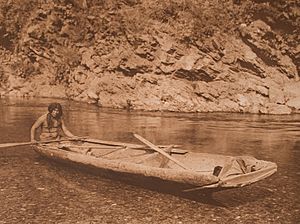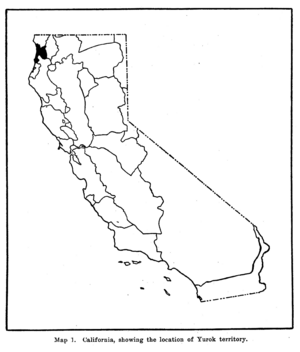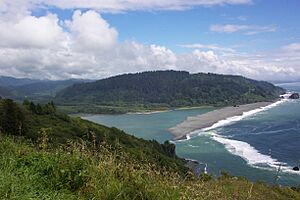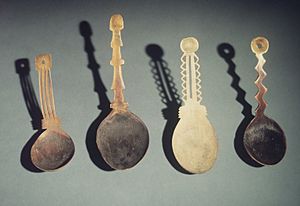Yurok facts for kids

Yurok man and canoe on the Trinity River by Edward S. Curtis, c. 1923
|
|
| Total population | |
|---|---|
| 6,567 alone and in combination (2010) | |
| Regions with significant populations | |
| Languages | |
| English, Yurok | |
| Religion | |
| traditional tribal religion, Christianity | |
| Related ethnic groups | |
| Wiyot |
The Yurok people are an Indigenous group from along the Klamath River and the Pacific coast. Their traditional lands stretch from Trinidad in the south to Crescent City in the north.
Today, the Yurok live on the Yurok Indian Reservation, Resighini Rancheria, and nearby areas. These are located in Humboldt, Del Norte, and Trinity counties. The reservation covers a large area along the Klamath River. However, only a small part of this land is owned by the tribe. Much of their traditional land is now owned by timber companies or is part of national parks. This has made it harder for the Yurok to use natural resources and practice their traditional ways of life.
Contents
Who Are the Yurok?
The Yurok call themselves 'Oohl (meaning "person"). They also use the name 'O'loolekweesh 'o'l / 'Oolekwoh, which means "village dwellers."
Yurok people living on the coast are called Ner'ernerh / Nert'ernerh ("Coast people"). Those living along the Klamath River are known as Hehlkeeklaa ("Klamath River people"). They use names like Pueleeklaa / Pueleekla' to show they are "downstream people." This helps tell them apart from the Karuk people, who live "upstream."
A Look at Yurok History
The Yurok have lived along the Klamath River for about 10,000 years. Their way of life has always been closely tied to the many salmon in the river. They traditionally lived in permanent villages. Some of these villages have been around since the 1300s.
The Yurok first met non-Native people in 1775 when Spanish explorers arrived. Later, fur traders came in 1827. In the 1850s, during a gold rush, many white settlers moved into Yurok lands. This led to diseases and conflicts. The Yurok population dropped by about 75%.
In 1855, a reservation was created along the Lower Klamath River. This reservation included some of the Yurok's traditional lands and villages.
Yurok Life Today
Fishing, hunting, and gathering food are still very important to the Yurok. They are also known for their beautiful basket weaving and woodcarving. In 1990, a traditional village of wooden plank buildings, called Sumeg, was built. Traditional dances like the Jump Dance and Brush Dance are still part of their ceremonies.
The Yurok Tribe is involved in many projects. They own a casino and offer river jet boat tours. The Yurok Tribe Construction Corporation works on various building projects. In 2023, this company helped create new channels for Chinook salmon along the Sacramento River. They added plants to these channels to give young salmon places to hide.
Caring for the Environment
Protecting Forests and Carbon Sequestration
The Yurok's traditional lands were once very large, about half a million acres. By 1993, this had shrunk to only about 5% of their original reservation.
However, the Yurok have been able to get some of their land back through a process called carbon sequestration. This means their forests absorb carbon dioxide from the air. By doing this, they earn credits that they can sell. This has helped them buy back land. By 2021, they owned about 100,000 acres.
Because of these efforts, the Yurok received the Equator Prize from the United Nations Development Program. The money they earn from carbon sequestration helps them pay off loans and support schools. It also helps with youth programs, housing, and road improvements. This allows them to manage their land in a sustainable way.
Some people have concerns about this system. They worry that it allows polluting companies to continue polluting. Others feel the Yurok should get their land back without having to sell their forest's ability to store carbon.
Wind Power and Tribal Concerns
In February 2024, the Yurok held a meeting about offshore wind power. This meeting helped Native communities learn about how these new energy projects might affect their food, culture, and income. A key point was that offshore wind farms should not be built in tribal areas without the tribe's permission.
Tribal leaders are worried about their role in making decisions. They discussed two wind farms planned near Humboldt. They are concerned about how these large projects might impact local ports and surrounding areas.
Yurok Chairman Joseph L. James said that tribes do not want other industries to take advantage of their natural resources. They want to make sure their communities benefit.
In March 2024, the Yurok Tribal Council decided to oppose offshore wind farms near their coast. They gave several reasons:
- The tall wind turbines would harm sacred cultural sites.
- There isn't enough scientific research on how these floating turbines might affect the environment. They worry about risks to the ocean and the Klamath River.
- The government has not recognized the Yurok Tribe's traditional ocean territory or their right to decide what happens there.
The Yurok Tribe joins other tribes, like the Bear River Band and the Tolowa Dee-ni' Nation, in opposing these projects.
Forest Management and Redwoods
On March 20, 2024, the Yurok began a special agreement to manage tribal lands with the National Park Service. This agreement also involves the Save the Redwoods League. This new partnership aims to change how natural lands are managed. It recognizes the value of tribal land management.
The agreement involves 125 acres of land, which the Yurok call 'O Rew. This land was once a lumber mill for 50 years. The Yurok see Redwoods as living beings. They traditionally only used fallen trees to build homes and canoes.
Plans for 'O Rew include building traditional redwood plank houses, a sweat house, and a visitor and cultural center. The center will display sacred items like deerskins and baskets. It will also be a place for the Yurok to practice their traditions.
For a long time, the Yurok were not allowed to manage their own forest resources. This was done under the idea of "scientific forest management." But this prevented the Yurok from getting food and resources in their traditional ways. The Yurok Fisheries Department now works to help salmon and steelhead trout in the streams. Tribal members also plant trees to help stabilize riverbanks and reduce dirt in the water.
The Yurok Language
Yurok is one of two Algic languages spoken in California. The other is Wiyot. Today, between 20 and 100 people speak the Yurok language. The language is being taught through special teams and by singing. Classes are offered at Humboldt State University and at language camps.
An interesting thing about the Yurok language is that some nouns change depending on if there is one, two, or three of an object. For example, one person is ko:ra, two people are ni'iyel, and three people are nahkseyt.
Yurok Culture
Food and Salmon
The Yurok traditionally fished for salmon in rivers. They also gathered ocean fish and shellfish. They hunted game and collected plants. They ate many different berries and meats. Whale meat was especially valued. Yurok people did not hunt whales. Instead, they waited for a drift whale to wash up on the beach. Then they would dry the meat.
Salmon is a very important food source for the Yurok. It provides vital nutrients. The Yurok people have a deep connection to salmon. They believe salmon are a gift from the Creator. Salmon are central to Yurok identity and way of life.
In the past, huge numbers of salmon swam up the Klamath River to lay their eggs. But now, salmon numbers are much lower. This is due to changing climate and water quality issues. This decline is a serious problem for the Yurok. Their life and culture are closely tied to the fish of the Klamath and Trinity rivers.
The Yurok Tribe hopes that removing four dams along the Klamath River will help the salmon return. This will open up nearly 400 miles of old salmon habitat.
Salmon also give the Yurok the strength and focus for their arts, like basketry. Without salmon, it would be harder to create and preserve their beautiful culture.
Condor Restoration Efforts
California condors (called 'prey-go-neesh' by the Yurok) are seen as powerful spiritual beings by Indigenous people. The Yurok and other tribes use shed condor feathers in healing ceremonies.
The Yurok Tribe Northern California Condor Restoration Program is working to bring the California condor back to the area. Condors were last seen there around 1892. The Bald Hills are part of the Yurok Tribal lands.
The tribe started this program in 2008 because condors are important culturally and ecologically. They use both modern science and traditional Yurok knowledge from elders. They have tested local wildlife for harmful chemicals like lead. They also built a special facility for the condors.
In May 2022, two condors were released in Redwood National Park. A third was released later, and a fourth in July. The birds are monitored with GPS transmitters. As of March 2024, 11 condors have been successfully introduced. More are planned for release this year.
Returning Sacred Items
In 2010, the Smithsonian Institution returned 217 sacred items to the Yurok tribe. These items included condor feathers, headdresses, and deerskins. They had been in the Smithsonian's collection for almost 100 years. This was one of the largest returns of Native American items. These items will be used in Yurok ceremonies and displayed at the tribe's cultural center.
Yurok Society
Villages and Homes

Yurok villages (called 'o'loolekw) were made up of separate family homes. The oldest man in the family owned the house. Several generations of men related through their father lived there. Their wives, children, and other relatives also lived with them.
Yurok villages also had sweat houses. These were special places for men to gather. Land was usually passed down from fathers to their sons. Daughters and other male relatives also received some property.
Community Leaders
Yurok society did not have chiefs. Instead, each village had a wealthy man called a peyerk who acted as a leader. Elders trained the peyerk. This training included a vision quest, where they connected with nature and the spirit world.
Peyerk from different villages would meet to solve tribal problems. They also hosted tribal ceremonies. During these times, the peyerk would provide food and shelter for the Yurok people. They also provided special clothing for the dancers. Peyerk often lived in homes at higher elevations and wore finer clothes.
Yurok medicine people were usually women. Women became shamans after dreaming that they were told to do so. Another shaman would help them with a special dance. Shamans used plants, prayers, and rituals to heal people. They also performed ceremonies for successful hunting, fishing, and gathering.
Every year, the Yurok held a World Renewal Ceremony. During this event, songs and dances passed down through generations were performed. Dancers wore special clothing for the occasion.
Yurok society had different social groups: syahhlew ("rich"), wa's'oyowok' / wa'soyowok' ("poor"), and ka'aal ("slaves"). Only the syahhlew were allowed to perform religious duties. Men sometimes became slaves if they owed money to families. However, slavery was not a major part of their society. The higher a man's social standing, the more valuable his life was considered.
Marriage Customs

When daughters got married, Yurok families received a payment from the husband. Girls were highly valued in the family. The amount of money a man paid for his bride showed the social status of the couple. A wealthy man who paid a large sum would raise the social rank of his family and children. After marriage, both spouses kept their own property. The bride lived with the groom's family and took his last name.
If a man could not pay the full amount, he could pay half. This was called being "half-married." Half-married couples lived with the bride's family. The groom would then become like a helper for them. Their children would take the mother's last name.
Either spouse could ask for a divorce. The most common reason for divorce was if the wife could not have children. If the woman wanted a divorce and to take the children, her family had to pay back the husband's initial payment.
Yurok Population
In 1770, there were an estimated 2,500 to 3,100 Yurok people. By 1870, this number had dropped to 1,350. In 1910, it was around 668 to 700.
According to the 2000 United States Census, there were 4,413 Yurok living in California. This included those of full Yurok descent and those with ancestors from different tribes. Across the United States, there were 5,793 Yurok.
The Yurok Indian Reservation is California's largest tribe. In 2019, it had 6,357 members. In 1993, the Yurok Tribe created a constitution for their lands. Many people chose to become Yurok members. Most of these members lived within 50 miles of the reservation.
The Yurok reservation covers about 63,035 acres. However, about 80% of the people living there experience poverty. Also, 70% of the residents do not have phone service or electricity.
Notable Yurok People
- Rick Bartow (1946–2016), a talented painter, printmaker, and sculptor.
- Archie Thompson (1919–2013), an elder who helped bring back the Yurok language.
- Lucy Thompson (1856–1932), the first Indigenous Californian woman to have her writings published.
See also
 In Spanish: Yurok para niños
In Spanish: Yurok para niños
- Yurok traditional narratives
- Un-Dam the Klamath
- Restoration of the Elwha River
- Manifest destiny




